
In 1980, the Jerusalem Law is passed by the Knesset, declaring a united Jerusalem as the official capital of Israel.
In 1984, Operation Moses brings 7,000 Ethiopian Jews to Israel.
Rampant inflation endangers the fragile Israeli economy. An emergency economic plan initiated by Prime Minister Shimon Peres and Finance Minister Yitzhak Modai in 1985 stabilizes the situation.
In 1987, the first intifada (Palestinian uprising) begins in the West Bank and the Gaza Strip. In the late 80’s, Soviet Premier Mikhail Gorbachev announces a new policy of peristroika (restructuring) and glasnost (openness).
In 1989, the second mass wave of Soviet immigration to Israel begins.


WIZO Milestones
1980 – WIZO sends a delegation to the UN Women’s Mid-Decade Conference in Copenhagen.
Two classes for disadvantaged girls open in WIZO centers in Eilat and Beersheva. WIZO Israel opens Third Age Department to work with senior citizens.
1981 – The Mothercraft Training Center (MTC) is closed at the request of the Ministry of Social Affairs, in keeping with early age psychologists’ new policy against closed institutions for young children.
WIZO USA Federation is established in New York and Miami at the initiative of Raya Jaglom, following a “gentlewomen’s agreement” between WIZO and the women’s organization active in the USA, Hadassah. Evelyn Sommer is elected its first president.
(In the photo above: WIZO USA Florida branch with Raya Jaglom and Evelyn Sommer, 1985. Photo: David Karp)
1982 – Neve WIZO, four special foster family homes for children, opens in Herzliya, sponsored by WIZO South Africa, to provide a solution for children from the MTC who have no alternative family arrangement.
Beit Heuss expands its activities, begins regular week-long recreational and support workshops for groups of women and couples with problems, in cooperation with the Ministry of Labor and Social Affairs.
(In the photo above: Beit Heuss hosts soldiers during the First Lebanon War, also known as Operation Peace for Galilee.)
First WIZO club for Bedouin women opens in Shibli.
First WIZO club for Circassian women opens in Reihania.
1983 – WIZO Israel opens Rachel Kagan Leadership Seminar.
WIZO USA Federation is established in New York and Miami at the initiative of Raya Jaglom, following a “gentlewomen’s agreement” between WIZO and the women’s organization active in the USA, Hadassah.

1984 – First Shelter for Battered Women is opened by WIZO Israel Status of Women Department, at the initiative of Michal Modai.
(In the photo: Women’s Shelter in southern Israeli city. Photo by Uri Luzatti.)
Student’s Club for children of working mothers is opened at Jerusalem Baby Home and Family Center.
First non-residential Therapeutic Child Center is opened in Azur by WIZO Israel Dept. for Family and Community Welfare, headed by Tamar Lewin, for children from troubled homes, in cooperation with Ministry of Social Welfare.
1985 – WIZO sends a delegation to the UN End of Women’s Decade Conference in Nairobi.
The permanent premises of WIZO Jerusalem Vocational School for Girls (now co-ed), sponsored by British WIZO, is opened at Jerusalem Family Center.
1986 – WIZO Paula Gold de Leonescu Parents Home for senior citizens is inaugurated in Tel Aviv on the site of the former Mothercraft Training Center.
1987 – WIZO Israel’s 24-hour emergency telephone hotline for abused women, the first in the country, is established, initiated by Ruth Tekoah.
The first and only Shelter for Girls in Distress, later named in honor of Ruth Tekoah, is opened.
1988 – The first after-school center for homework assistance and hot lunches, in the Judith Moshevich Center run by WIZO Israel’s Department of Family and Community, opens in Tel Aviv’s Yad Eliahu neighborhood.
1989 – 300 young women from Israel and around the Jewish world mark the 10th anniversary of International WIZO Aviv Seminars and the 50th anniversary of the outbreak of WWII with a special seminar – “From Holocaust to Rebirth” – in Poland and Israel. The special seminar is initiated and organized by Rachel Limon, head of World WIZO’s Organization Department, and includes a demonstration at Auschwitz against the presence of a Carmelite convent.
With the beginning of the second wave of mass immigration from the Soviet Union, WIZO recruits and trains volunteers and prepares infrastructure to assist in their absorption. Chain of after-school centers is expanded throughout the country.


